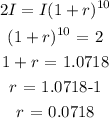Answer;

Explanation;
a) We want to get the initial population of the bacteria
We start by writing a formula that links the initial bacteria population to a later bacteria population after time t

where A(t) is the bacteria population at time t
I is the initial bacteria population
r is the rate of increase in population
t is time
Now, let us find r
At t = 10; we know that A(t) = 2I
Thus, we have it that;

Now, let us find I, since we have r. But we have to make use of t= 80 and A(t) = 50,000
Thus, we have;

The initial population is 195 bacteria
b) For after 4 hours, we have to convert to minutes
We know that there are 60 minutes in an hour
So, in 4 hours, we have 4 * 60 = 240 minutes
Now, we proceed to use the formula above with I = 195 and t = 240
We have that as;
